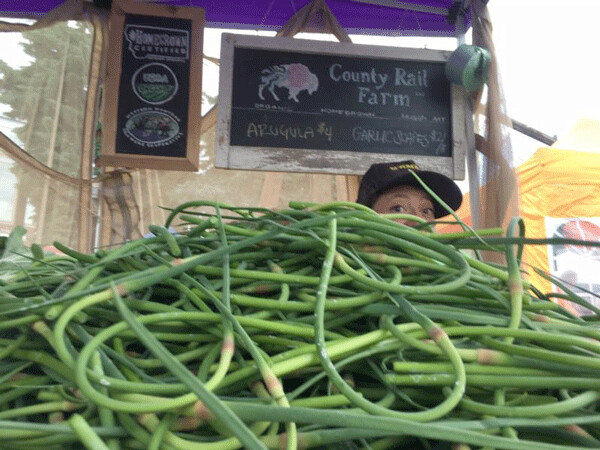News & Articles
Browse all content by date.

For garlic lovers, this time of year is like an early holiday season. As we speak, delicious edible flower stalks called scapes are curling their ways from the tops of hardneck garlic plants. When they are available, it’s like a combination of Thanksgiving and Christmas to those who know what to do with a scape. The arrival of scapes means that garlic harvest is just a few weeks away, ushering a New Year of garlic. The farmers markets will then be awash with bright new bulbs wrapped in still-succulent peels.
But let’s not get ahead of ourselves. Now is the time to enjoy those scapes, and to appreciate our first taste of fresh garlic since this time last year.
Their whimsical, fiery curls can be used as spice or vegetable. Cooked whole, they resemble spears of coiled asparagus-as many as two full curls per scape, which makes it tricky to dunk one into some sauce and wrangle into your mouth with any dignity. So rather than making scapes the centerpiece of a meal, I usually chop them into bite-sized pieces if I want the vegetable, or mince it if I want the spice. As with all garlic, cooking will soften the flavor of a scape.
For gardeners, scapes offer endless delight, but prospective scape buyers can also benefit from understanding how they grow.
Planted in fall, garlic sets root and then lies dormant throughout the winter. In early spring, the young garlic plants shoot from the ground, leaving your neighbors’ gardens in the dust.
The scapes begin to emerge from the garlic plants in late spring, and start to curl soon after. If left to their own devices the scapes will curl all the way around, and then around a second time, and then completely uncurl and stand straight up. The pointy tip will swell into a large purple flower that looks like an exploding firework. If you do have garlic in the ground, it’s worth letting a few plants flower just for the beautiful spectacle.
But just leave a few, because removing the scapes not only results in early garlic to eat, it also makes the garlic bulbs grow larger, for the same reason that castrating a steer will make its body grow bigger. When you remove the energy-intensive distraction of reproduction, the plant can give all of its resources to the bulb. So for gardeners and market growers, pulling scapes is a win-win, because they can sell the scapes in spring, and their eventual garlic harvest will be larger because of it.
When harvesting scapes for market, most growers will let them curl once or twice before picking them, but not me. I go after those scapes the minute they appear, like I would go after an army of poisonous spiders in my kitchen. I don’t want those scapes to live a minute longer than necessary, because they are basically parasites stealing my garlic.
Scapes can be snipped, snapped or pulled, and I prefer the latter. I harvest scapes the way you’d pull on a blade of grass on which you wish to chew. If you tug with sustained, gentle pressure the scape will snap off somewhere in the plant, and slowly emerge with slurping suck. The part from inside the plant is tender as sushi.
Thus, when shopping, the most important thing to look at is the broken end of the scape. If harvested young, and via pulling, the end will be appropriately tender. But if the scape was allowed to curl around once or twice, the cut end may very well be woody, and will have to be trimmed before it can be used, as with asparagus.
One of my favorite ways to cook scapes is in a stovetop frittata with eggs and potatoes. Thin-slice a potato or two into enough slices to coat the bottom of a pan. Pour a slug of olive oil (or use butter or bacon, or all of the above) and cook on medium until the potatoes are browned on the bottom and cooked through. Push the potatoes to the side of the pan and add chopped scapes. Cook them in the oil until they smell done but are still bright green, then stir them together with the potatoes, spreading them evenly about the pan. Beat two eggs, and season them with salt, pepper and garlic powder.
I happened to have some unsweetened whipped cream in the fridge, so I gingerly folded an obscenely heaping tablespoon into the eggs. That’s completely optional, but highly advised.
Pour the eggs into the pan, tilting it around for even spreading. Cook on low with the lid on, checking frequently, until the top is done to your liking. Instead of cream, one could add cheese, perhaps something soft, like brie, or something hard grated.
It may seem like a breakfast-ey type of meal, but like many breakfasts, scape frittata can be prepared all day long. Indeed, one of the cooler things about scapes are that they can last virtually forever in a paper bag in the fridge. So if you’re into scapes, now is the time to stalk up for the whole year.

| Tweet |


